Assessing the Effect of Age and Geomorphic Setting on Organic Carbon Accumulation in High-Latitude Human-Planted Mangroves
Abstract
:1. Introduction
2. Materials and Methods
2.1. Study Area
2.2. Sampling and Samples Pre-Treatment
2.3. Sediment and Plant Tissue Analyses
2.4. Sediment Organic Carbon Stock Calculation
2.5. Statistical Analyses
3. Results
3.1. Grain Size Analyses
3.2. Bulk TOC, TN and δ13C
3.3. Organic Carbon Stocks
4. Discussion
4.1. Sediment Accumulation in Mangroves
4.2. Sources and Decay of Sedimentary Organic Matter
4.3. Storage of Sedimentary Organic Carbon
5. Conclusions
Author Contributions
Funding
Institutional Review Board Statement
Informed Consent Statement
Data Availability Statement
Acknowledgments
Conflicts of Interest
Appendix A
| Depth | Mz | σ | Sk | Ku | DBD |
|---|---|---|---|---|---|
| cm | φ | φ | g cm−3 | ||
| S1 | |||||
| Surface | 7.32 | 1.40 | 0.55 | 2.73 | 0.96 |
| 0–20 | 7.39 ± 0.06 | 1.43 ± 0.02 | 0.45 ± 0.07 | 2.67 ± 0.04 | 0.97 ± 0.03 |
| 20–40 | 7.37 ± 0.08 | 1.45 ± 0.03 | 0.46 ± 0.05 | 2.63 ± 0.06 | 1.01 ± 0.07 |
| 40–60 | 7.37 ± 0.07 | 1.44 ± 0.02 | 0.49 ± 0.06 | 2.65 ± 0.04 | 0.99 ± 0.04 |
| 60–80 | 7.38 ± 0.09 | 1.44 ± 0.01 | 0.46 ± 0.09 | 2.67 ± 0.06 | 1.19 ± 0.03 |
| 80–100 | 7.47 ± 0.02 | 1.44 ± 0.01 | 0.40 ± 0.01 | 2.59 ± 0.02 | 1.12 ± 0.07 |
| L1 | |||||
| Surface | 7.51 | 1.39 | 0.41 | 2.74 | 0.84 |
| 0–20 | 7.53 ± 0.07 | 1.39 ± 0.00 | 0.45 ± 0.04 | 2.66 ± 0.05 | 0.93 ± 0.08 |
| 20–40 | 7.39 ± 0.08 | 1.44 ± 0.01 | 0.48 ± 0.08 | 2.67 ± 0.04 | 1.06 ± 0.11 |
| 40–60 | 7.44 ± 0.12 | 1.45 ± 0.02 | 0.44 ± 0.04 | 2.58 ± 0.04 | 0.99 ± 0.06 |
| 60–80 | 7.39 ± 0.11 | 1.45 ± 0.02 | 0.49 ± 0.07 | 2.61 ± 0.07 | 1.06 ± 0.04 |
| 80–100 | 7.45 ± 0.08 | 1.46 ± 0.04 | 0.44 ± 0.05 | 2.55 ± 0.02 | 1.18 ± 0.02 |
| S2 | |||||
| Surface | 7.33 | 1.50 | 0.49 | 2.55 | 0.91 |
| 0–20 | 7.27 ± 0.10 | 1.41 ± 0.05 | 0.52 ± 0.13 | 2.87 ± 0.15 | 0.95 ± 0.06 |
| 20–40 | 7.35 ± 0.15 | 1.43 ± 0.08 | 0.49 ± 0.13 | 2.72 ± 0.24 | 1.00 ± 0.08 |
| 40–60 | 7.30 ± 0.20 | 1.48 ± 0.03 | 0.46 ± 0.18 | 2.74 ± 0.21 | 1.14 ± 0.03 |
| 60–80 | 7.30 ± 0.14 | 1.45 ± 0.03 | 0.50 ± 0.08 | 2.76 ± 0.14 | 1.13 ± 0.08 |
| 80−100 | 7.27 ± 0.13 | 1.44 ± 0.04 | 0.47 ± 0.11 | 2.74 ± 0.14 | 1.15 ± 0.05 |
| L2 | |||||
| Surface | 7.12 | 1.35 | 0.49 | 3.00 | 0.82 |
| 0–20 | 7.27 ± 0.17 | 1.42 ± 0.05 | 0.43 ± 0.03 | 2.79 ± 0.22 | 0.83 ± 0.02 |
| 20–40 | 7.34 ± 0.13 | 1.44 ± 0.05 | 0.43 ± 0.08 | 2.70 ± 0.18 | 0.89 ± 0.04 |
| 40–60 | 7.34 ± 0.17 | 1.51 ± 0.03 | 0.41 ± 0.11 | 2.56 ± 0.10 | 1.08 ± 0.05 |
| 60–80 | 7.39 ± 0.10 | 1.48 ± 0.04 | 0.36 ± 0.13 | 2.65 ± 0.13 | 1.04 ± 0.06 |
| 80–100 | 7.33 ± 0.06 | 1.44 ± 0.04 | 0.54 ± 0.04 | 2.76 ± 0.11 | 0.97 ± 0.03 |
| Depth | TOC | TN | C/N | δ13C | OCstock |
|---|---|---|---|---|---|
| cm | % | % | ‰ | Mg Corg ha−1 | |
| S1 | |||||
| Surface | 0.91 | 0.127 | 8.3 | −23.17 | 1.73 |
| 0–20 | 0.84 ± 0.21 | 0.126 ± 0.023 | 7.7 ± 0.65 | −22.58 ± 0.37 | 16.23 |
| 20–40 | 0.68 ± 0.04 | 0.114 ± 0.007 | 7.0 ± 0.18 | −22.48 ± 0.23 | 13.80 |
| 40–60 | 0.66 ± 0.03 | 0.113 ± 0.004 | 6.8 ± 0.14 | −22.74 ± 0.12 | 13.02 |
| 60–80 | 0.62 ± 0.03 | 0.110 ± 0.003 | 6.6 ± 0.20 | −22.76 ± 0.08 | 14.83 |
| 80–100 | 0.62 ± 0.04 | 0.105 ± 0.006 | 6.9 ± 0.31 | −22.79 ± 0.10 | 13.84 |
| L1 | |||||
| Surface | 2.04 | 0.220 | 10.8 | −26.07 | 3.42 |
| 0–20 | 1.23 ± 0.49 | 0.157 ± 0.040 | 8.9 ± 1.17 | −24.75 ± 1.01 | 22.88 |
| 20–40 | 0.73 ± 0.05 | 0.116 ± 0.002 | 7.4 ± 0.38 | −23.29 ± 0.11 | 15.45 |
| 40–60 | 0.65 ± 0.02 | 0.116 ± 0.005 | 6.5 ± 0.07 | −22.88 ± 0.15 | 12.85 |
| 60–80 | 0.69 ± 0.03 | 0.120 ± 0.006 | 6.8 ± 0.20 | −22.85 ± 0.19 | 14.71 |
| 80–100 | 0.68 ± 0.02 | 0.112 ± 0.002 | 7.1 ± 0.30 | −22.86 ± 0.24 | 16.04 |
| S2 | |||||
| Surface | 0.70 | 0.139 | 5.9 | −22.08 | 1.27 |
| 0–20 | 0.70 ± 0.05 | 0.125 ± 0.009 | 6.5 ± 0.43 | −22.06 ± 0.27 | 13.21 |
| 20–40 | 0.64 ± 0.05 | 0.115 ± 0.005 | 6.5 ± 0.19 | −22.33 ± 0.09 | 12.80 |
| 40–60 | 0.63 ± 0.02 | 0.110 ± 0.003 | 6.6 ± 0.10 | −22.41 ± 0.12 | 14.19 |
| 60–80 | 0.64 ± 0.04 | 0.113 ± 0.003 | 6.6 ± 0.37 | −22.57 ± 0.17 | 14.55 |
| 80–100 | 0.64 ± 0.03 | 0.114 ± 0.005 | 6.6 ± 0.33 | −22.61 ± 0.13 | 14.77 |
| L2 | |||||
| Surface | 0.79 | 0.131 | 7.1 | −21.99 | 1.30 |
| 0–20 | 0.84 ± 0.03 | 0.132 ± 0.003 | 7.4 ± 0.24 | −21.98 ± 0.24 | 13.94 |
| 20–40 | 0.70 ± 0.04 | 0.115 ± 0.006 | 7.1 ± 0.22 | −22.30 ± 0.09 | 12.44 |
| 40–60 | 0.59 ± 0.02 | 0.100 ± 0.005 | 6.9 ± 0.27 | −22.20 ± 0.14 | 12.75 |
| 60–80 | 0.64 ± 0.04 | 0.113 ± 0.006 | 6.6 ± 0.26 | −22.34 ± 0.15 | 13.37 |
| 80–100 | 0.67 ± 0.04 | 0.121 ± 0.002 | 6.5 ± 0.37 | −22.37 ± 0.14 | 13.03 |
References
- Jennerjahn, T.C.; Ittekkot, V. Relevance of mangroves for the production and deposition of organic matter along tropical continental margins. Naturwissenschaften 2002, 89, 23–30. [Google Scholar] [CrossRef] [PubMed]
- Duke, N.C. Mangrove Floristics and Biogeography Revisited: Further Deductions from Biodiversity Hot Spots, Ancestral Discontinuities, and Common Evolutionary Processes. In Mangrove Ecosystems: A Global Biogeographic Perspective; Springer International Publishing: Cham, Switzerland, 2017; pp. 17–53. ISBN 9783319622064. [Google Scholar]
- Alongi, D.M. Carbon cycling and storage in mangrove forests. Ann. Rev. Mar. Sci. 2014, 6, 195–219. [Google Scholar] [CrossRef] [PubMed]
- Cavanaugh, K.C.; Dangremond, E.M.; Doughty, C.L.; Park Williams, A.; Parker, J.D.; Hayes, M.A.; Rodriguez, W.; Feller, I.C. Climate-driven regime shifts in a mangrove–salt marsh ecotone over the past 250 years. Proc. Natl. Acad. Sci. USA 2019, 116, 21602–21608. [Google Scholar] [CrossRef] [PubMed] [Green Version]
- Alongi, D.M. Carbon balance in salt marsh and mangrove ecosystems: A global synthesis. J. Mar. Sci. Eng. 2020, 8, 767. [Google Scholar] [CrossRef]
- Alongi, D.M. Carbon sequestration in mangrove forests. Carbon Manag. 2012, 3, 313–322. [Google Scholar] [CrossRef]
- Furukawa, K.; Wolanski, E. Sedimentation in Mangrove Forests. Mangroves Salt Marshes 1996, 1, 3–10. [Google Scholar] [CrossRef]
- Furukawa, K.; Wolanski, E.; Mueller, H. Currents and Sediment Transport in Mangrove Forests. Estuar. Coast. Shelf Sci. 1997, 44, 301–310. [Google Scholar] [CrossRef]
- Rovai, A.S.; Twilley, R.R.; Castañeda-Moya, E.; Riul, P.; Cifuentes-Jara, M.; Manrow-Villalobos, M.; Horta, P.A.; Simonassi, J.C.; Fonseca, A.L.; Pagliosa, P.R. Global controls on carbon storage in mangrove soils. Nat. Clim. Chang. 2018, 8, 534–538. [Google Scholar] [CrossRef]
- Twilley, R.R.; Rovai, A.S.; Riul, P. Coastal morphology explains global blue carbon distributions. Front. Ecol. Environ. 2018, 16, 503–508. [Google Scholar] [CrossRef] [Green Version]
- McKee, K.L.; Cahoon, D.R.; Feller, I.C. Caribbean mangroves adjust to rising sea level through biotic controls on change in soil elevation. Glob. Ecol. Biogeogr. 2007, 16, 545–556. [Google Scholar] [CrossRef]
- Adame, M.F.; Kauffman, J.B.; Medina, I.; Gamboa, J.N.; Torres, O.; Caamal, J.P.; Reza, M.; Herrera-Silveira, J.A. Carbon Stocks of Tropical Coastal Wetlands within the Karstic Landscape of the Mexican Caribbean. PLoS ONE 2013, 8, e56569. [Google Scholar] [CrossRef] [Green Version]
- Sasmito, S.D.; Sillanpää, M.; Hayes, M.A.; Bachri, S.; Saragi-Sasmito, M.F.; Sidik, F.; Hanggara, B.B.; Mofu, W.Y.; Rumbiak, V.I.; Hendri, S.T.; et al. Mangrove blue carbon stocks and dynamics are controlled by hydrogeomorphic settings and land-use change. Glob. Chang. Biol. 2020, 26, 3028–3039. [Google Scholar] [CrossRef] [PubMed] [Green Version]
- Sasmito, S.D.; Kuzyakov, Y.; Lubis, A.A.; Murdiyarso, D.; Hutley, L.B.; Bachri, S.; Friess, D.A.; Martius, C.; Borchard, N. Organic carbon burial and sources in soils of coastal mudflat and mangrove ecosystems. Catena 2020, 187, 104414. [Google Scholar] [CrossRef]
- Sanders, C.J.; Smoak, J.M.; Naidu, A.S.; Sanders, L.M.; Patchineelam, S.R. Organic carbon burial in a mangrove forest, margin and intertidal mud flat. Estuar. Coast. Shelf Sci. 2010, 90, 168–172. [Google Scholar] [CrossRef]
- Meyers, P.A. Preservation of elemental and isotopic source identification of sedimentary organic matter. Chem. Geol. 1994, 114, 289–302. [Google Scholar] [CrossRef] [Green Version]
- Bouillon, S.; Connolly, R.M.; Lee, S.Y. Organic matter exchange and cycling in mangrove ecosystems: Recent insights from stable isotope studies. J. Sea Res. 2008, 59, 44–58. [Google Scholar] [CrossRef] [Green Version]
- Bouillon, S.; Dahdouh-Guebas, F.; Rao, A.V.V.S.; Koedam, N.; Dehairs, F. Sources of organic carbon in mangrove sediments: Variability and possible ecological implications. Hydrobiologia 2003, 495, 33–39. [Google Scholar] [CrossRef]
- Tue, N.T.; Hamaoka, H.; Sogabe, A.; Quy, T.D.; Nhuan, M.T.; Omori, K. The application of δ13C and C/N ratios as indicators of organic carbon sources and paleoenvironmental change of the mangrove ecosystem from Ba Lat Estuary, Red River, Vietnam. Environ. Earth Sci. 2011, 64, 1475–1486. [Google Scholar] [CrossRef]
- Kusumaningtyas, M.A.; Hutahaean, A.A.; Fischer, H.W.; Pérez-Mayo, M.; Ransby, D.; Jennerjahn, T.C. Variability in the organic carbon stocks, sources, and accumulation rates of Indonesian mangrove ecosystems. Estuar. Coast. Shelf Sci. 2019, 218, 310–323. [Google Scholar] [CrossRef]
- Tue, N.T.; Ngoc, N.T.; Quy, T.D.; Hamaoka, H.; Nhuan, M.T.; Omori, K. A cross-system analysis of sedimentary organic carbon in the mangrove ecosystems of Xuan Thuy National Park, Vietnam. J. Sea Res. 2012, 67, 69–76. [Google Scholar] [CrossRef]
- Stringer, C.E.; Trettin, C.C.; Zarnoch, S.J. Soil properties of mangroves in contrasting geomorphic settings within the Zambezi River Delta, Mozambique. Wetl. Ecol. Manag. 2016, 24, 139–152. [Google Scholar] [CrossRef]
- Atwood, T.B.; Connolly, R.M.; Almahasheer, H.; Carnell, P.E.; Duarte, C.M.; Ewers Lewis, C.J.; Irigoien, X.; Kelleway, J.J.; Lavery, P.S.; Macreadie, P.I.; et al. Global patterns in mangrove soil carbon stocks and losses. Nat. Clim. Chang. 2017, 7, 523–528. [Google Scholar] [CrossRef]
- Marchand, C. Soil carbon stocks and burial rates along a mangrove forest chronosequence (French Guiana). For. Ecol. Manag. 2017, 384, 92–99. [Google Scholar] [CrossRef]
- Li, S.-B.; Chen, P.-H.; Huang, J.-S.; Hsueh, M.-L.; Hsieh, L.-Y.; Lee, C.-L.; Lin, H.-J. Factors regulating carbon sinks in mangrove ecosystems. Glob. Chang. Biol. 2018, 24, 4195–4210. [Google Scholar] [CrossRef] [PubMed]
- Gao, Y.; Zhou, J.; Wang, L.; Guo, J.; Feng, J.; Wu, H.; Lin, G. Distribution patterns and controlling factors for the soil organic carbon in four mangrove forests of China. Glob. Ecol. Conserv. 2019, 17, e00575. [Google Scholar] [CrossRef]
- Pham, V.H.; Luu, V.D.; Nguyen, T.T.; Koji, O. Will restored mangrove forests enhance sediment organic carbon and ecosystem carbon storage? Reg. Stud. Mar. Sci. 2017, 14, 43–52. [Google Scholar] [CrossRef]
- Xiong, Y.; Liao, B.; Wang, F. Mangrove vegetation enhances soil carbon storage primarily through in situ inputs rather than increasing allochthonous sediments. Mar. Pollut. Bull. 2018, 131, 378–385. [Google Scholar] [CrossRef]
- Tao, Y.; Huang, X.; Wang, X.; Zhong, Q.; Kang, Z. Spatial distribution of soil carbon and nitrogen stocks in Mangrove Wetland of Xiandao Park and Shajing in Guangxi. Prog. Fish. Sci. 2020, 41, 38–45, (In Chinese with English Abstract). [Google Scholar] [CrossRef]
- Zhao, C.; Jiang, Z.; Wu, Y.; Liu, S.; Cui, L.; Zhang, J.; Huang, X. Origins of sediment organic matter and their contributions at three contrasting wetlands in a coastal semi-enclosed ecosystem. Mar. Pollut. Bull. 2019, 139, 32–39. [Google Scholar] [CrossRef]
- Liao, Y.; Shou, L.; Tang, Y.; Zeng, J.; Chen, Q.; Yan, X. Effects of non-indigenous plants on food sources of intertidal macrobenthos in Yueqing Bay, China: Combining stable isotope and fatty acid analyses. Estuar. Coast. Shelf Sci. 2020, 241, 106801. [Google Scholar] [CrossRef]
- Li, L.; Zhang, H.; Shi, A.; Li, D. Study on Wetland Landscape Pattern Change in the Ximen Island Marine Special Protected Area based on RS and GIS. Remote Sens. Technol. Appl. 2013, 28, 129–136. [Google Scholar]
- Devaney, J.L.; Pullen, J.; Feller, I.C.; Parker, J.D. Low humidity and hypersalinity reduce cold tolerance in mangroves. Estuar. Coast. Shelf Sci. 2021, 248, 107015. [Google Scholar] [CrossRef]
- Alexander, S.; Nelson, C.R.; Aronson, J.; Lamb, D.; Cliquet, A.; Erwin, K.L.; Finlayson, C.M.; de Groot, R.S.; Harris, J.A.; Higgs, E.S.; et al. Opportunities and Challenges for Ecological Restoration within REDD+. Restor. Ecol. 2011, 19, 683–689. [Google Scholar] [CrossRef]
- Li, J.; Xu, H.; Ye, L.; Gu, J.; Wang, R. Introduction and afforestation technique of Kandelia candel to the north. J. Zhejiang For. Sci. Technol. 2001, 21, 51–53. (In Chinese) [Google Scholar]
- Zheng, J.; Wang, J.; Chen, Q.; Xu, J.; Li, X.; Lu, X.; Lei, H.; Xia, H.; Zheng, S. Preliminary report on northward introduction experiment of several mangrove plants along the southern coast of Zhejiang Province. J. Southwest For. Univ. 2010, 30, 11–17, (In Chinese with English Abstract). [Google Scholar]
- Chen, Q.; Yang, S.; Wang, J.; Liu, X.; Zheng, J.; Deng, R. The development of mangroves in Zhejiang Province. J. Zhejiang Agric. Sci. 2019, 60, 1177–1181, (In Chinese with English Abstract). [Google Scholar] [CrossRef]
- Wang, A.; Chen, J.; Jing, C.; Ye, G.; Wu, J.; Huang, Z.; Zhou, C. Monitoring the invasion of Spartina alterniflora from 1993 to 2014 with Landsat TM and SPOT 6 satellite data in Yueqing Bay, China. PLoS ONE 2015, 10, e0135538. [Google Scholar] [CrossRef] [Green Version]
- Zheng, R.; Ge, B.; Zhang, Y.; Zheng, X. The comparative study on the macrobenthic community ecology between the man-grove swamp and the naked tidal flat at the Yueqing Bay. Ecol. Sci. 2006, 25, 299–302, (In Chinese with English Abstract). [Google Scholar]
- McManus, J. Grain size determination and interpretation. In Techniques in Sedimentology; Tucker, M., Ed.; Blackwell: Oxford, UK, 1988; pp. 63–85. ISBN 0-632-01361-3. [Google Scholar]
- Blott, S.J.; Pye, K. GRADISTAT: A grain size distribution and statistics package for the analysis of unconsolidated sediments. Earth Surf. Process. Landf. 2001, 26, 1237–1248. [Google Scholar] [CrossRef]
- Tu, Q.; Yang, S.; Zhou, Q.; Yang, J. Sediment transport and carbon sequestration characteristics along mangrove fringed coasts. Acta Oceanol. Sin. 2015, 34, 21–26. [Google Scholar] [CrossRef]
- Van Santen, P.; Augustinus, P.G.E.F.; Janssen-Stelder, B.M.; Quartel, S.; Tri, N.H. Sedimentation in an estuarine mangrove system. J. Asian Earth Sci. 2007, 29, 566–575. [Google Scholar] [CrossRef]
- Jiang, R.; Cheng, P.; Gao, J.; Wang, A. Impacts of mangrove on the dynamic process of bottom boundary layer. Mar. Geol. Front. 2020, 36, 37–44, (In Chinese with English Abstract). [Google Scholar] [CrossRef]
- Mazda, Y.; Magi, M.; Kogo, M.; Hong, P.N. Mangroves as a coastal protection from waves in the Tong King delta, Vietnam. Mangroves Salt Marshes 1997, 1, 127–135. [Google Scholar] [CrossRef]
- Zhu, Y.; Zhao, F.; Guo, J.; Wu, G.; Lin, G. Grain size characteristics of core sedimentation from the Gaoqiao mangrove area in Zhanjiang, Guangdong Province of southern China. J. Beijing For. Univ. 2017, 39, 9–17, (In Chinese with English Abstract). [Google Scholar] [CrossRef]
- Sly, P.G.; Thomas, R.L.; Pelletier, B.R. Comparison of sediment energy-texture relationships in marine and lacustrine environments. Hydrobiologia 1982, 91–92, 71–84. [Google Scholar] [CrossRef]
- Sihombing, Y.H.; Muskananfola, M.R.; A’in, C. Pengaruh kerapatan mangrove terhadap laju sedimentasi di desa bedono demak (The Effect of Mangrove Density on Sedimentation Rate in Bedono Village, Demak). Manag. Aquat. Resour. J. 2018, 6, 536–545. [Google Scholar] [CrossRef]
- Gonneea, M.E.; Paytan, A.; Herrera-Silveira, J.A. Tracing organic matter sources and carbon burial in mangrove sediments over the past 160 years. Estuar. Coast. Shelf Sci. 2004, 61, 211–227. [Google Scholar] [CrossRef]
- Lamb, A.L.; Wilson, G.P.; Leng, M.J. A review of coastal palaeoclimate and relative sea-level reconstructions using δ13C and C/N ratios in organic material. Earth-Sci. Rev. 2006, 75, 29–57. [Google Scholar] [CrossRef]
- Khan, M.N.I.; Suwa, R.; Hagihara, A. Carbon and nitrogen pools in a mangrove stand of Kandelia obovata (S., L.) Yong: Vertical distribution in the soil-vegetation system. Wetl. Ecol. Manag. 2007, 15, 141–153. [Google Scholar] [CrossRef]
- Zuo, X.; Cui, L.; Li, W.; Lei, Y.; Dou, Z.; Liu, Z.; Cai, Y.; Zhai, X. Spartina alterniflora leaf and soil eco-stoichiometry in the Yancheng coastal wetland. Plants 2021, 10, 13. [Google Scholar] [CrossRef] [PubMed]
- Dittmar, T.; Lara, R.J. Molecular evidence for lignin degradation in sulfate-reducing mangrove sediments (Amazônia, Brazil). Geochim. Cosmochim. Acta 2001, 65, 1417–1428. [Google Scholar] [CrossRef]
- Fourqurean, J.W.; Schrlau, J.E. Changes in nutrient content and stable isotope ratios of C and N during decomposition of seagrasses and mangrove leaves along a nutrient availability gradient in Florida Bay, USA. Chem. Ecol. 2003, 19, 373–390. [Google Scholar] [CrossRef]
- Muzuka, A.N.N.; Shunula, J.P. Stable isotope compositions of organic carbon and nitrogen of two mangrove stands along the Tanzanian coastal zone. Estuar. Coast. Shelf Sci. 2006, 66, 447–458. [Google Scholar] [CrossRef]
- Kennedy, H.; Gacia, E.; Kennedy, D.P.; Papadimitriou, S.; Duarte, C.M. Organic carbon sources to SE Asian coastal sediments. Estuar. Coast. Shelf Sci. 2004, 60, 59–68. [Google Scholar] [CrossRef]
- Ji, X.; Zhang, Y.; Zhu, D. Study on Marine Environment and Recent Coastal Evolution of Yueqing Bay, Zhejiang Province, China. Mar. Sci. Bull. 2006, 25, 44–53, (In Chinese with English Abstract). [Google Scholar]
- Tan, F.C.; Cai, D.L.; Edmond, J.M. Carbon isotope geochemistry of the Changjiang estuary. Estuar. Coast. Shelf Sci. 1991, 32, 395–403. [Google Scholar] [CrossRef]
- Xing, L.; Zhang, H.; Yuan, Z.; Sun, Y.; Zhao, M. Terrestrial and marine biomarker estimates of organic matter sources and distributions in surface sediments from the East China Sea shelf. Cont. Shelf Res. 2011, 31, 1106–1115. [Google Scholar] [CrossRef]
- Wang, Y.; Song, J.; Duan, L.; Yuan, H.; Li, X.; Li, N.; Zhang, Q.; Liu, J.; Ren, C. Combining sterols with stable carbon isotope as indicators for assessing the organic matter sources and primary productivity evolution in the coastal areas of the East China Sea. Cont. Shelf Res. 2021, 223, 104446. [Google Scholar] [CrossRef]
- Liu, H.; Ren, H.; Hui, D.; Wang, W.; Liao, B.; Cao, Q. Carbon stocks and potential carbon storage in the mangrove forests of China. J. Environ. Manag. 2014, 133, 86–93. [Google Scholar] [CrossRef]
- Wang, G.; Guan, D.; Peart, M.R.; Chen, Y.; Peng, Y. Ecosystem carbon stocks of mangrove forest in Yingluo Bay, Guangdong Province of South China. For. Ecol. Manag. 2013, 310, 539–546. [Google Scholar] [CrossRef]
- Lunstrum, A.; Chen, L. Soil carbon stocks and accumulation in young mangrove forests. Soil Biol. Biochem. 2014, 75, 223–232. [Google Scholar] [CrossRef]
- Liu, Y.C.; Hwang, C.; Han, J.; Kao, R.; Wu, C.R.; Shih, H.C.; Tangdamrongsub, N. Sediment-Mass accumulation rate and variability in the East China Sea detected by GRACE. Remote Sens. 2016, 8, 777. [Google Scholar] [CrossRef] [Green Version]
- Walcker, R.; Gandois, L.; Proisy, C.; Corenblit, D.; Mougin, É.; Laplanche, C.; Ray, R.; Fromard, F. Control of “blue carbon” storage by mangrove ageing: Evidence from a 66-year chronosequence in French Guiana. Glob. Chang. Biol. 2018, 24, 2325–2338. [Google Scholar] [CrossRef] [PubMed]
- Alongi, D.M. Global Significance of Mangrove Blue Carbon in Climate Change Mitigation. Science 2020, 2, 67. [Google Scholar] [CrossRef]
- Sanders, C.J.; Maher, D.T.; Tait, D.R.; Williams, D.; Holloway, C.; Sippo, J.Z.; Santos, I.R. Are global mangrove carbon stocks driven by rainfall? J. Geophys. Res. Biogeosci. 2016, 121, 2600–2609. [Google Scholar] [CrossRef]
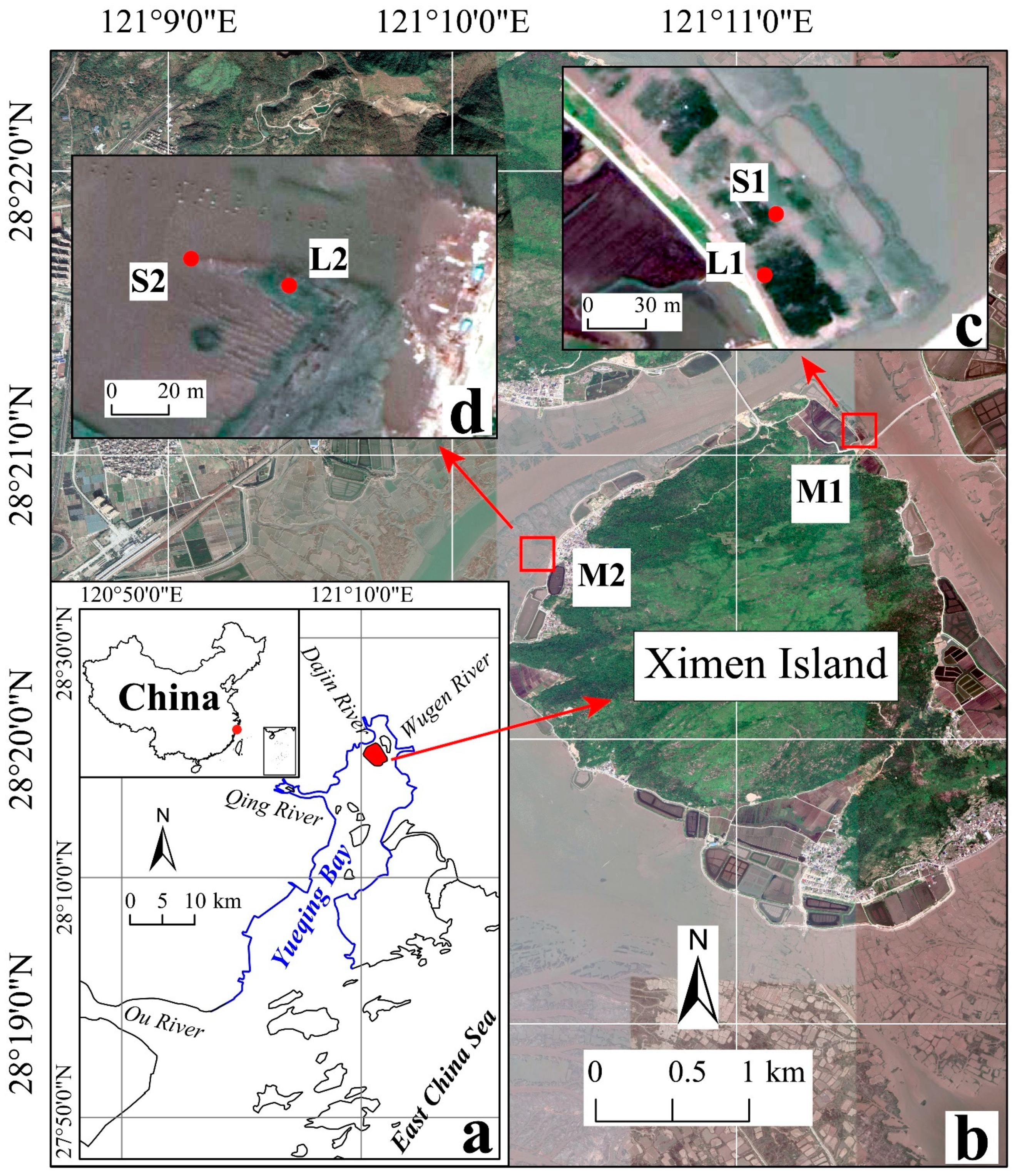
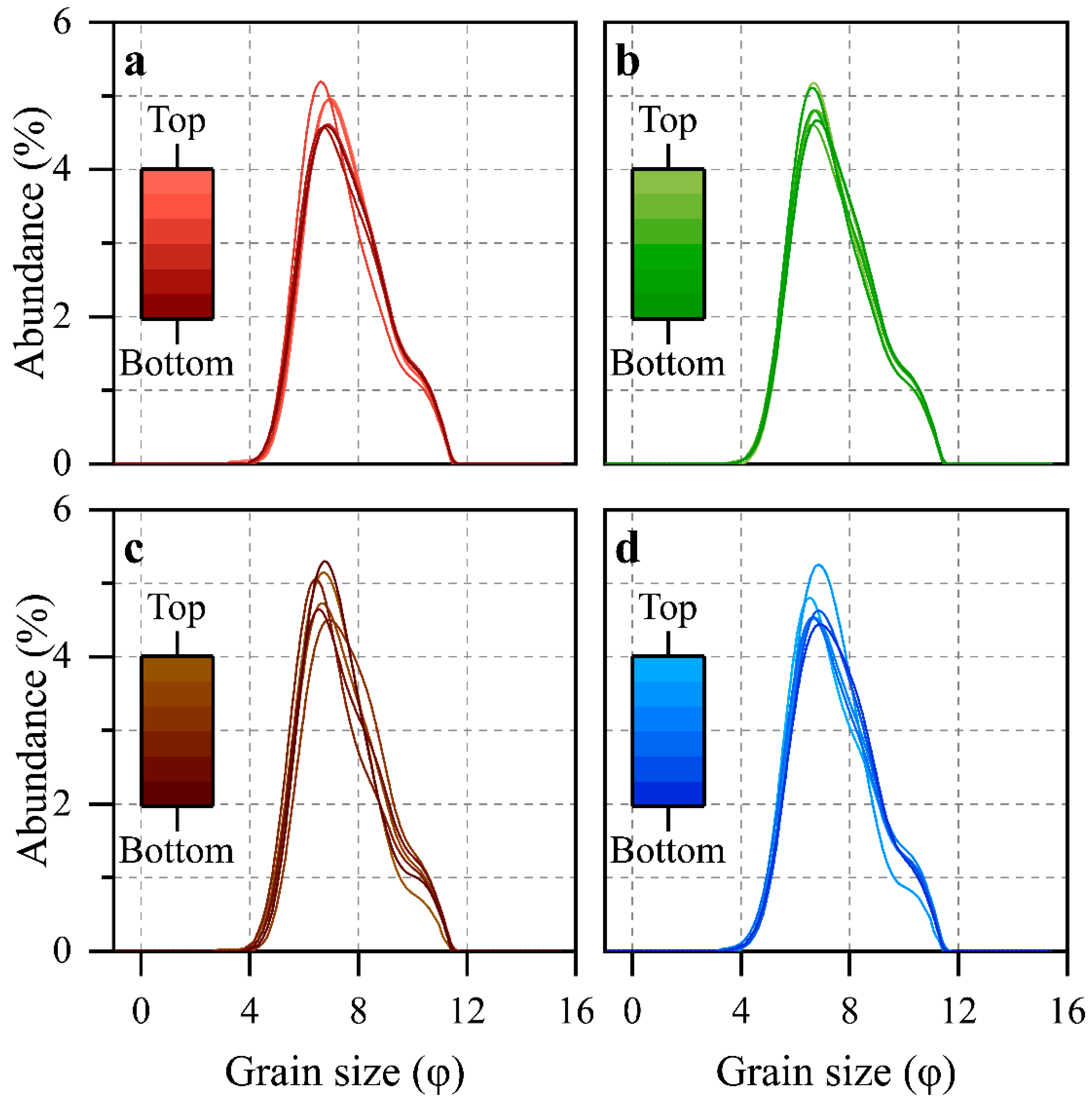
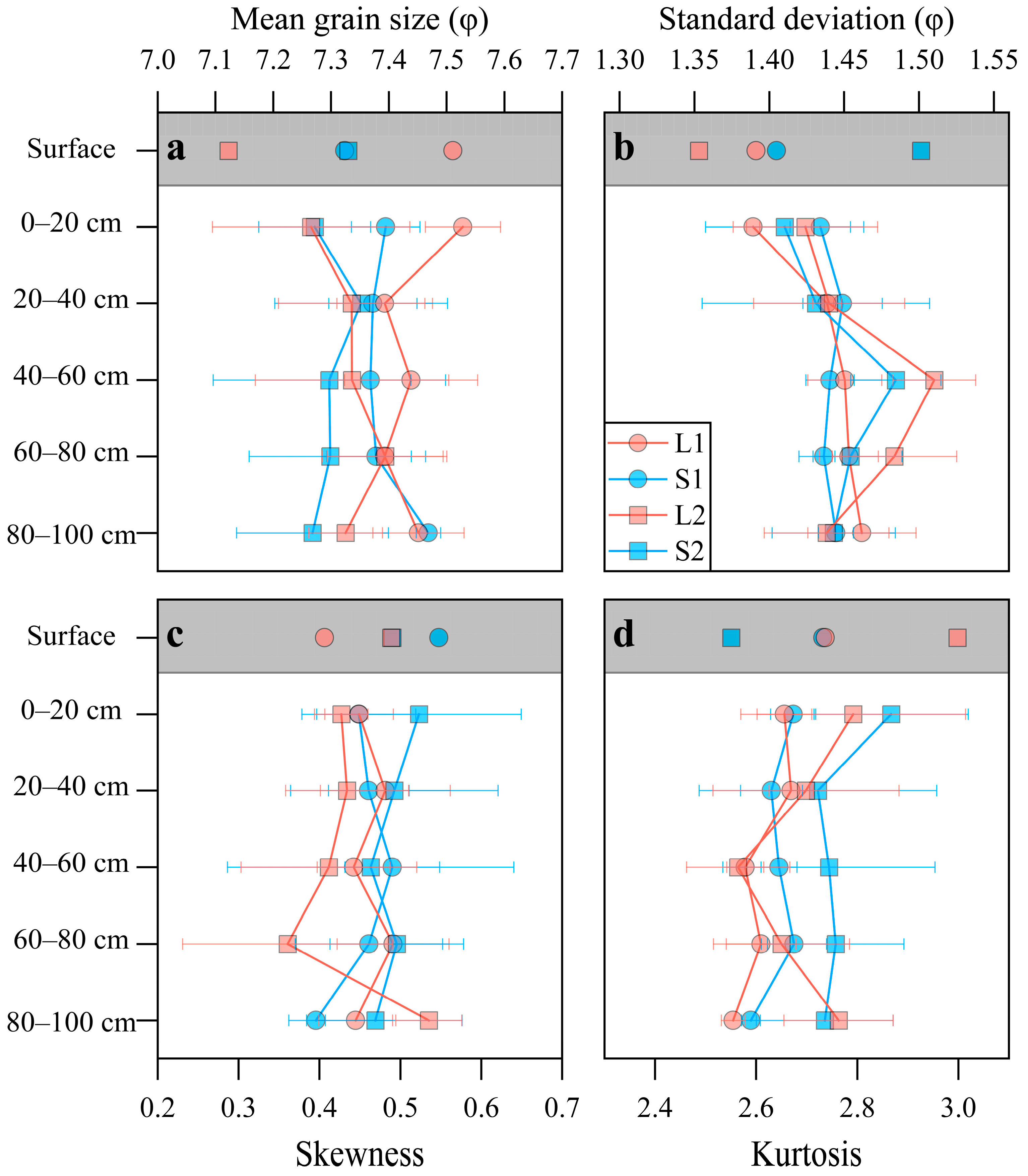
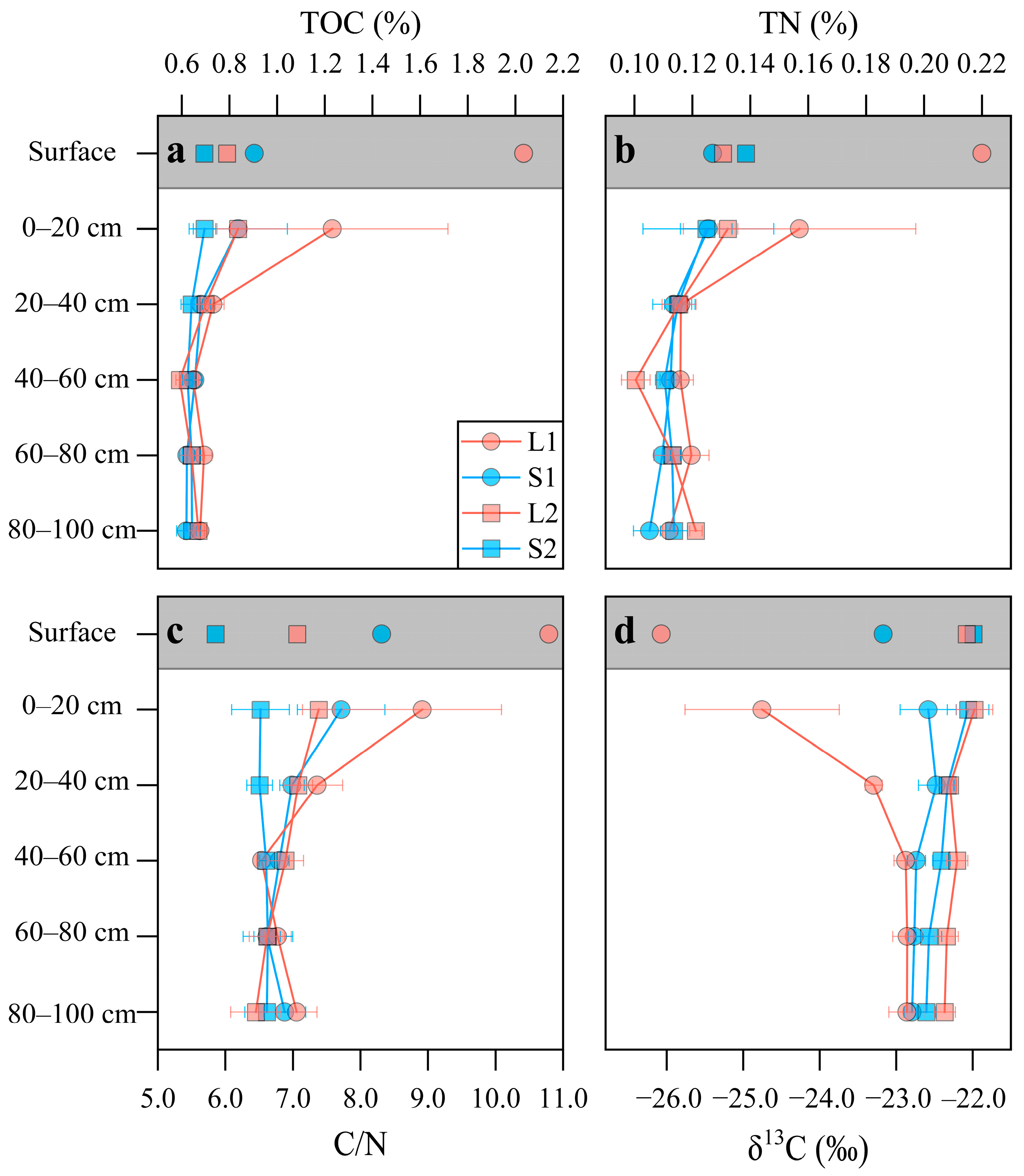
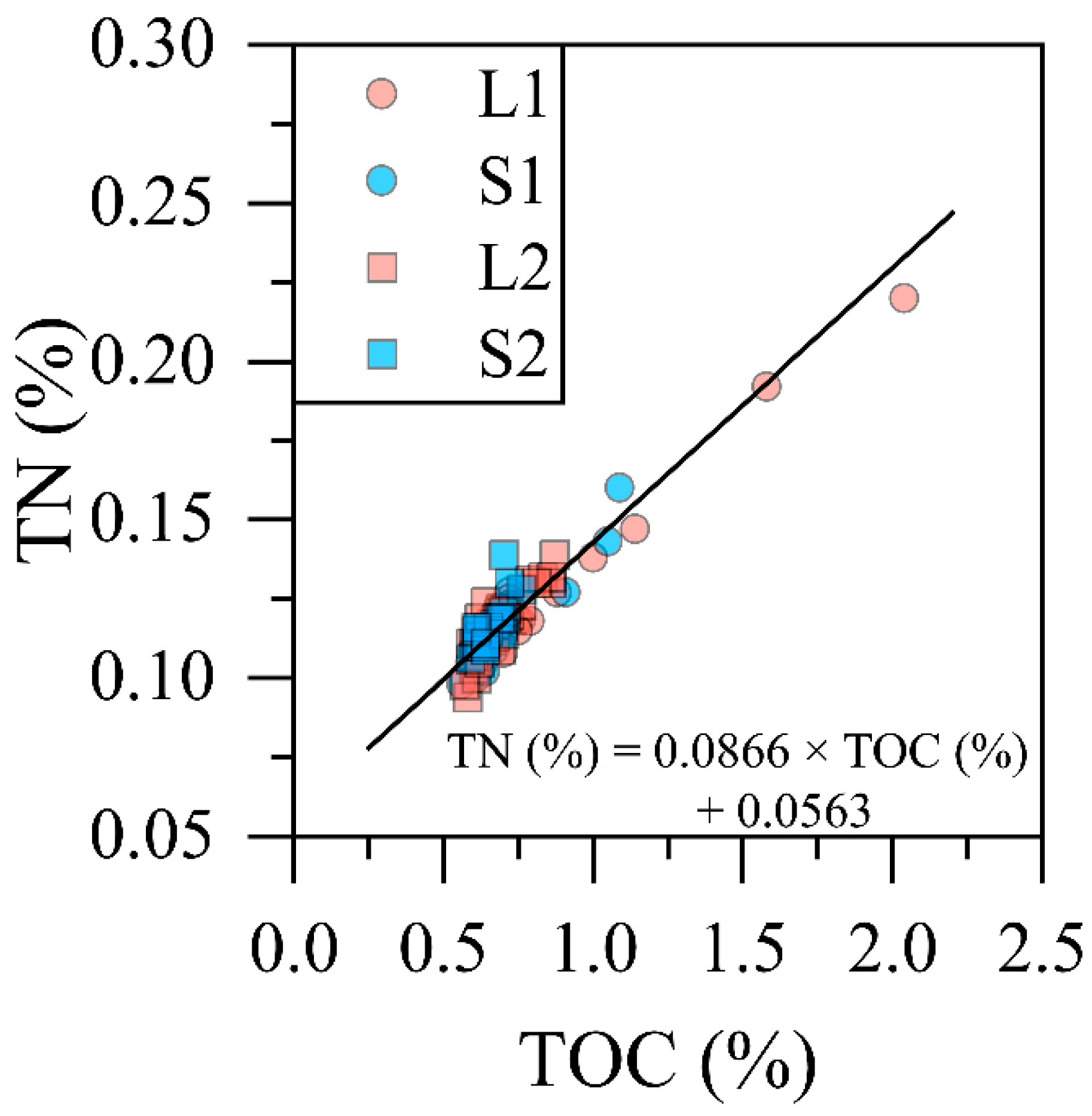
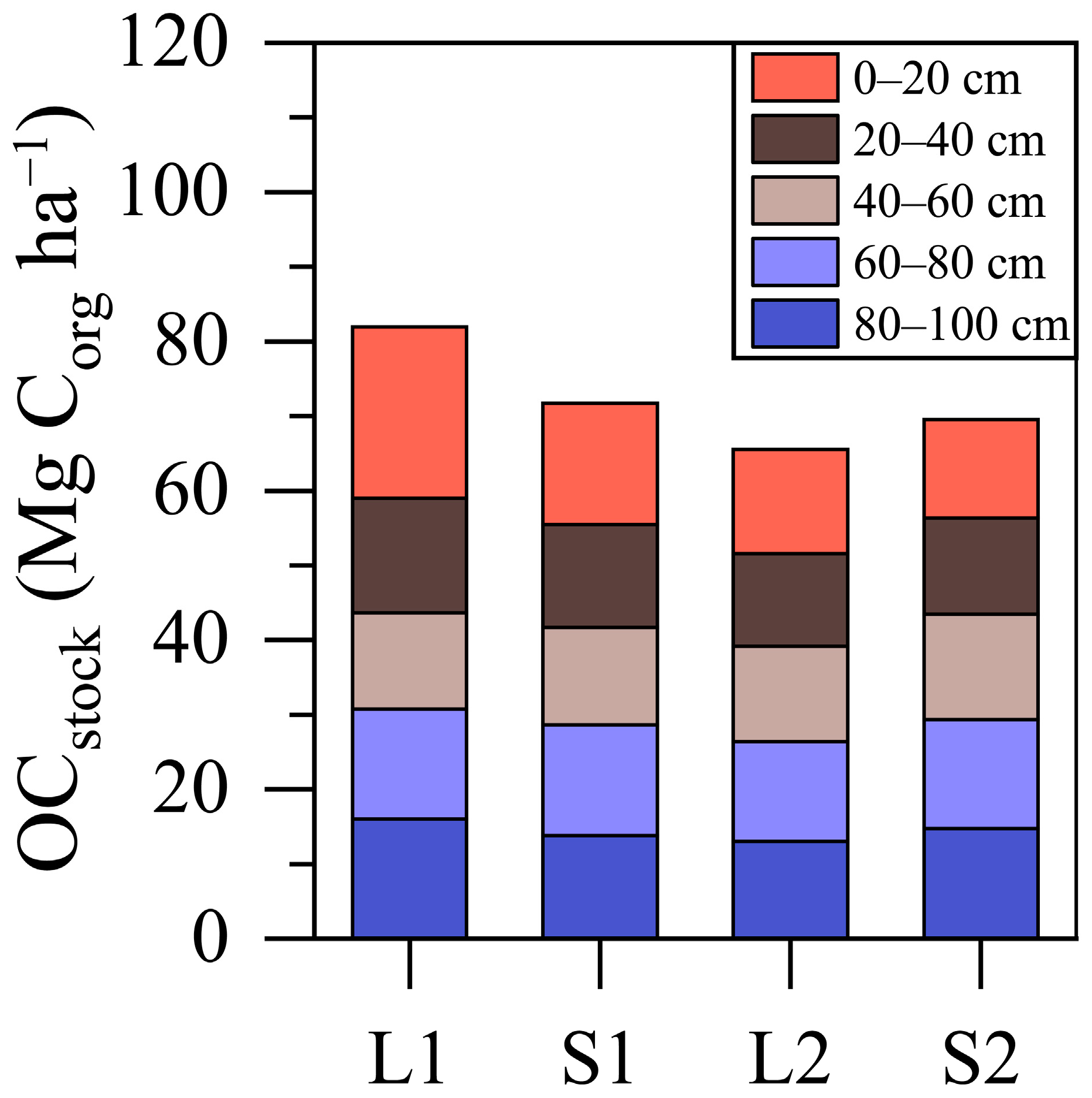
| TOC | TN | C/N | δ13C | Reference | |
|---|---|---|---|---|---|
| % | % | ‰ | |||
| Kandelia obovata | |||||
| Fresh leaf | 39.27 | 1.896 | 24.2 | −28.16 | This study |
| 41.9–47.2 | 1.26–1.99 | [51] | |||
| −28.1 ± 0.7 | [31] | ||||
| Fresh branch (with bark) | 39.50 | 1.129 | 40.8 | −27.76 | This study |
| Fresh branch bark | 45.6–48.6 | 0.564–0.842 | [51] | ||
| Fresh branch wood | 46.2–47.8 | 0.347–0.914 | [51] | ||
| Spartina alterniflora | |||||
| Fresh leaf | 37.43 | 1.614 | 27.1 | −14.74 | This study |
| −15.5 ± 0.4 | [31] | ||||
| 32.69–37.19 | 1.128–1.679 | 27.07–29.07 | [52] |
Publisher’s Note: MDPI stays neutral with regard to jurisdictional claims in published maps and institutional affiliations. |
© 2022 by the authors. Licensee MDPI, Basel, Switzerland. This article is an open access article distributed under the terms and conditions of the Creative Commons Attribution (CC BY) license (https://creativecommons.org/licenses/by/4.0/).
Share and Cite
Hu, J.; Loh, P.S.; Pradit, S.; Le, T.P.Q.; Oeurng, C.; Mohamed, C.A.R.; Lee, C.W.; Lu, X.; Anshari, G.Z.; Kandasamy, S.; et al. Assessing the Effect of Age and Geomorphic Setting on Organic Carbon Accumulation in High-Latitude Human-Planted Mangroves. Forests 2022, 13, 105. https://doi.org/10.3390/f13010105
Hu J, Loh PS, Pradit S, Le TPQ, Oeurng C, Mohamed CAR, Lee CW, Lu X, Anshari GZ, Kandasamy S, et al. Assessing the Effect of Age and Geomorphic Setting on Organic Carbon Accumulation in High-Latitude Human-Planted Mangroves. Forests. 2022; 13(1):105. https://doi.org/10.3390/f13010105
Chicago/Turabian StyleHu, Jianxiong, Pei Sun Loh, Siriporn Pradit, Thi Phuong Quynh Le, Chantha Oeurng, Che Abdul Rahim Mohamed, Choon Weng Lee, Xixi Lu, Gusti Z. Anshari, Selvaraj Kandasamy, and et al. 2022. "Assessing the Effect of Age and Geomorphic Setting on Organic Carbon Accumulation in High-Latitude Human-Planted Mangroves" Forests 13, no. 1: 105. https://doi.org/10.3390/f13010105
APA StyleHu, J., Loh, P. S., Pradit, S., Le, T. P. Q., Oeurng, C., Mohamed, C. A. R., Lee, C. W., Lu, X., Anshari, G. Z., Kandasamy, S., Wang, J., Li, Z., Qin, H., Ji, L., & Guo, J. (2022). Assessing the Effect of Age and Geomorphic Setting on Organic Carbon Accumulation in High-Latitude Human-Planted Mangroves. Forests, 13(1), 105. https://doi.org/10.3390/f13010105







